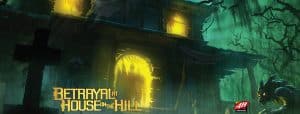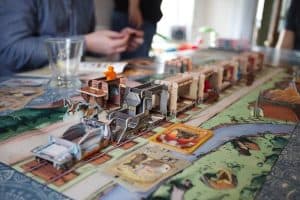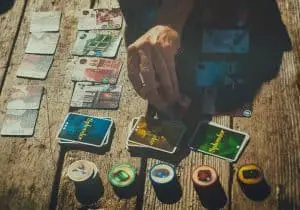Legacy board games are the new hot genre to hit the table top scene. First introduced in 2011, Legacy games are still finding their feet in the gaming community and have had controversial and mixed reaction from gamers.
Some people swear by Legacy games and absolutely love the idea. Others despise the concept. When looking at what a legacy game is its easy to see why…
What is a Legacy Game?
As the name suggests… legacy board games are games where players build THEIR legacy. Each game is tailor made for your group. Every decision you as players make has real, dynamic and permanent differences in the game.
I mentioned earlier that the genre is still finding its feet, and that’s true. But there are a few consistencies in most legacy games and I’ve listed these below:
- The games are meant to be played over the course of several session long campaigns (with the same players).
- The games are changed permanently by player decisions during the course of play.
- Game pieces are modified and destroyed during the game.
- Legacy games are designed to be on-going – the stories continue from where players left off.
It’s easy to see why someone would be put off – destroying game pieces… games that have one campaign that can only be played once? Why would you waste your money?
All these questions are legitimate, BUT, no where else will you find a board game that has a story that is more personalised and tailored to your exact group of friends in any other genre.
When playing a legacy board game your decisions matter. Other than Dungeons & Dragons, I have never been so immersed and invested in a story than with Legacy board games. And one thing is for certain – Legacy games are not going anywhere anytime soon.
In this article I will list what I believe to be the 10 best legacy board games and why.
Top 10 Best Legacy Board Games
- Risk: Legacy
- Gloomhaven
- Pandemic Legacy: Season 1
- Pandemic Legacy: Season 2
- Ultimate Werewolf Legacy
- Betrayal Legacy
- Charterstone
- First Martians: Adventures on the Red Planet
- Aeons End: Legacy
- SeaFall
1. Risk: Legacy
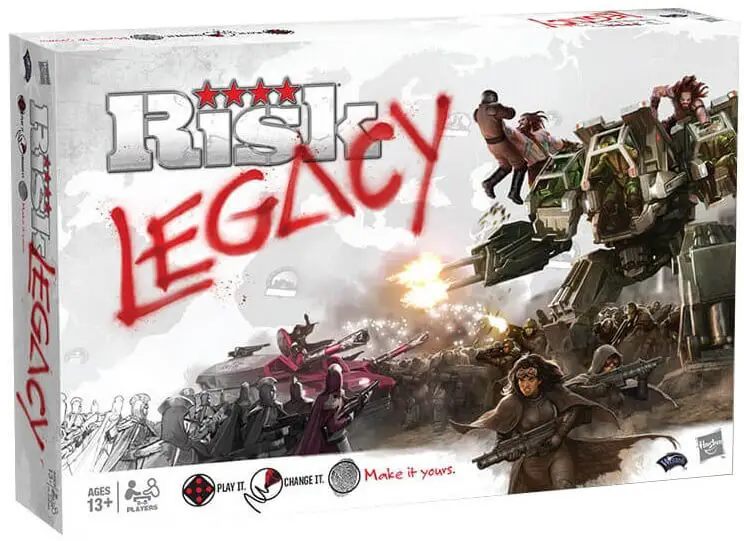
Players: 3 – 5
Duration: 60mins – 90mins
Risk: Legacy is the game that started the whole legacy genre. The original popular game of world domination was adapted into a legacy version by legendary game designer Rob Daviau.
And it was a huge hit!
The game is brilliant. It takes everything that was great about the traditional risk game and turned it into an absolutely epic campaign.
During the game, players are able to make so many personalised permanent differences to the game including actually changing the rulebook (the book actually comes with blank spaces for new and adapted rules to be written down during play).
Gameplay
It’s tough to write about legacy games without ruining too much of the story. Most of the fun is the surprises that are encountered along the journey (and Risk: Legacy is an EPIC journey).
In this article I will cover the high-level concepts of the game, but will shy away from any game ruining details. I’ll leave these surprises for you to discover should you decide to play.
Risk is one of the most popular war board games of all time. The games overarching theme is world domination and it puts players on the front line of this war.
Risk: Legacy starts off as a typical game of Risk, but it quickly becomes evident that decisions players makes in the game has very real and permanent consequences.
Players start the game choosing one of 5 factions, each with its own pieces and starting rules and they get to select one of two unique abilities (in the form of power cards) – this is the first permanent decision in the game as the power card not chosen, is physically destroyed.
That’s how discarding a card in a legacy game works. They are physically torn and destroyed. Gone. Never to be seen again.
Unlike classic Risk, the game is not played until someone dominates the whole world. Instead the easiest way to win is to acquire 4 stars. This happens by either controlling an opponent’s HQ or turning territory cards.
Players play through the game as normal. Each time a game is played, the decisions of players can make temporary and permanent changes to the game. These vary from changes to the rules and how the game is played – down to renaming entire continents and placing stickers on cards.
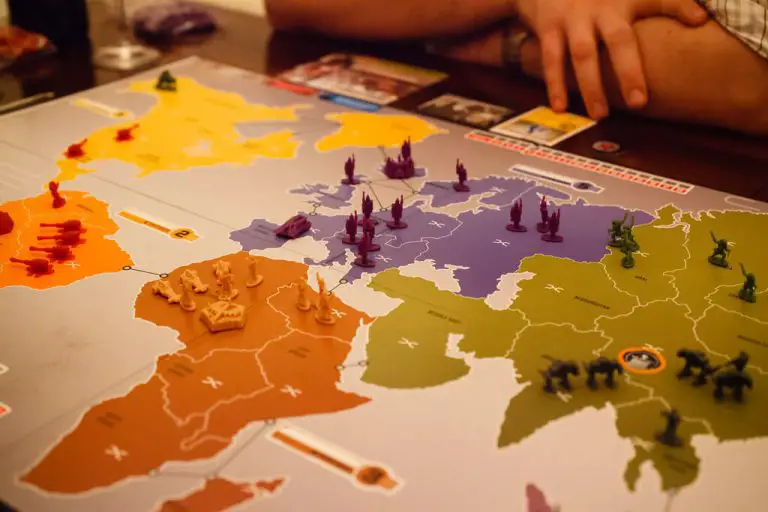
The game is played through 15 rounds (complete play throughs) and the winner of each round is tracked on the board.
This game is by far one of the most fun Legacy games I have played. I love the customisation aspect of the board in renaming continents and major cities.
I was so invested in this campaign that my friends and I completed all 15 rounds in 2 weeks. The best part is – every time you purchase and play through this game, you can 100% guarantee a unique experience!
For a more in-depth look at the gameplay of Risk: Legacy, check out my article on the best war games.
Bottom Line
Risk: Legacy was the first Legacy board game. It takes the original game of risk and turns it into a massive campaign that sucks players in and keeps them wanting more.
It has everything you could want from a legacy game: Destruction, stickers, rule changes and more!
Pros:
- Permanent, persistent changes make the game super fun and customized
- Destroying cards, defacing a game board and tearing open sealed packets – yes please
- A single play through lasts between 30mins and 60mins
Cons:
- No replayability
- If one player consistently wins – the game can become pretty unbalanced
2. Gloomhaven
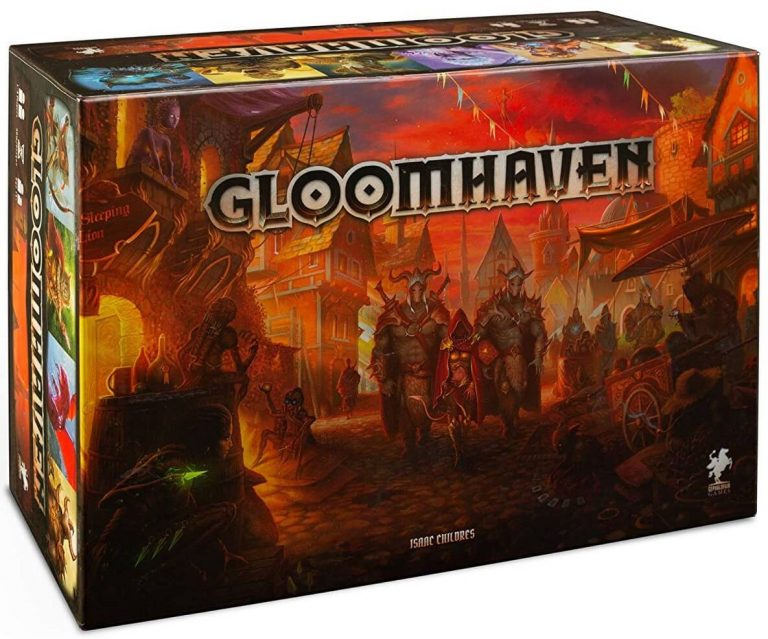
Players: 1 – 5
Duration: 120mins – 180mins
Gloomhaven is a game I keep coming back to in my lists of the best games. It has made appearances in my best RPG, Dungeon crawl and Co-op board game lists and now its listed here too! and there’s a good reason why…
Gloomhaven is one of the best campaign board games EVER!
I would go so far as to say Gloomhaven is the closest a board game can get to an actual Dungeons & Dragons campaign in terms of how its played and the depth and captivation of its story.
It would appear most board gamers are in agreement with me as Gloomhaven has been the No.1 board game on BGG for a long long time!
They’ve even turned it into a video game on steam.
The game incorporates a really cool legacy aspect where player decisions completely change the campaign and story of the game and allows you to essentially ‘choose your own destiny’.
Character progress and items are obviously choices which are permanent and follow through each of the 95 scenarios that make up the campaign of Gloomhaven.
Decisions players make during the game change the entire story of the campaign and means that each play through of the game is unique and refreshing.
There is no destruction of game pieces or cards in the game which is lucky as it would be a crime to allow such a thing to happen. The artwork and design elements in the game are amazing!
Gloomhaven is a legacy game you can replay over and over again.
I absolutely adore this game and love to play through a scenario with my friends every chance I get.
Gameplay
Gloomhaven is a huge game. The game comes with 17 playable characters, 47 enemy classes and a campaign with 95 different scenarios. It is an absolute behemoth.
I have covered the gameplay of Gloomhaven in depth in my other articles. So, I will only briefly touch on the gameplay in this section.
Gloomhaven was dreamt up and created by the game designer Isaac Childres and was an adaption of a Dungeons and Dragons campaign that he played with his friends. The game plays very similar to how a D&D game would play, without the need for a Dungeon master.
The game is an RPG at heart where players play as one of the 17 playable characters, each with unique skills and attributes.
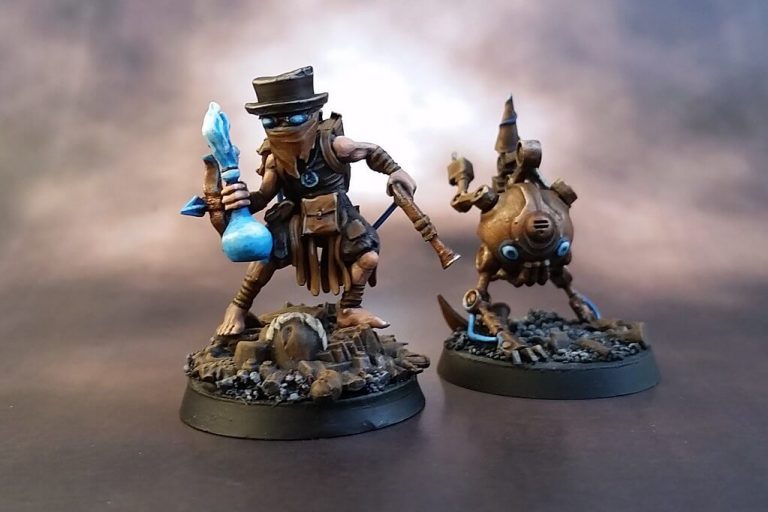
Players level up and progress their characters and the story by playing through scenarios of the game. These are essentially ‘dungeons’ with objectives that players need to defeat.
Combat in the game is super tactical and relies heavily on strategy. Instead of using dice, the game introduces a really clever mechanic of combat cards. These cards use initiative statistics which determine the order actions are performed and by which characters. This is hugely important as it shapes the strategies in game.
Each card has two actions that can be performed – these are usually an attack function and a support or movement function.
As players play through scenarios there are certain choices and paths that players need to take. These paths have huge impacts on the story arc of the game and the way things happen in the future.
Bottom Line
Gloomhaven is a board game that is hard to fault. It is an absolute masterpiece of a game.
The game is incredibly immersive and deep. When playing time seems to just fly by.
If you are looking for a legacy game that you can continue to enjoy and play over and over without needing to purchase the entire game again. Gloomhaven is a must have in your collection.
Pros:
- Unique card system
- Multiple hours of gameplay
- Game is incredibly immersive
- Classes are unique and have different abilities/play styles
- The game is balanced
- The rules are clean and easy to read and understand
- Loads of different enemy types keeps the game interesting
- Replayability
Cons:
- Enemy AI could use a bit of a tweak – movement is very simple
- The game can feel grindy
- Game takes a decent amount of time to set up
3. Pandemic Legacy: Season 1

Players: 2 – 4
Duration: 60mins
Pandemic is a hugely popular cooperative board game that was released in 2008 and paved the way for the cooperative board game scene.
The mechanics and concepts introduced by Pandemic had an amazing reception in the gaming community and prompted a snowball of new cooperative games that built on the foundations Pandemic presented.
It’s no wonder then that Pandemic was the second game adapted to incorporate a legacy mechanic by the same game designer (Rob Daviau) who created Risk: Legacy and is now also paving the way for Legacy games!
Pandemic Legacy: Season 1 is a masterpiece of a game and sits at No. 2 on the boardgamegeek rankings only recently dethroned from its No. 1 position by Gloomhaven.
The game takes the classic Pandemic game and turns it into an epic 12 – 24 session campaign (depending how good your team is) where you are fighting to find a cure for a disease that threatens humanity.
My friends and I absolutely LOVED playing through season 1 and 2 (mentioned next in the list) of Pandemic. We are eagerly awaiting season 3 which is hinted to be released later this year!
Gameplay
NOTE: You will probably notice that there are two version of the game available – a red and blue version.
These are exactly the same game – but when combined the boxes create a cool panorama – purely artistic expression!
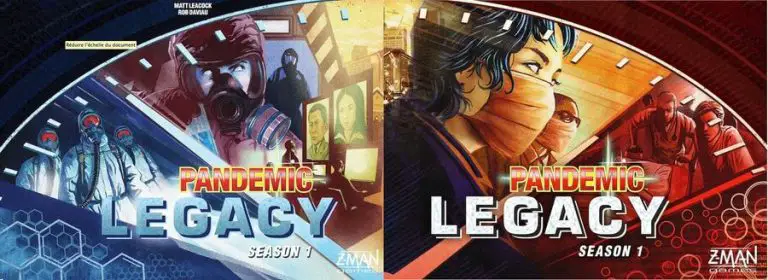
The world is in peril! There are a series of deadly diseases that have broken out all across the globe and are threatening to wipe out humanity! You and your team are disease fighting specialists who need to work together to stop the 4 diseases that threaten the human race before it’s too late!
Set up for the legacy version of the game is very similar to the original game. Players choose their characters, draw infection cards and player decks are created.
If you’d like to read a bit more detail about the original pandemic gameplay, check out my article here.
The legacy edition of the game takes the original game and turns it into a campaign designed to take place over 12 months.
Each play through of the game is one month. If players succeed and complete all objectives – they are able to continue into the next month.
If not… they will need to retry and arrive into the next month ‘Late’. This creates a theoretical maximum of 24 rounds of gameplay… however generally it falls within the 14 – 19 range.
Regardless of the result of the scenario, players get the option of 2 end of scenario ‘upgrades. These come in a variety of forms and affect the rest of the game and the way it is played. I won’t go into too much detail so as not to spoil it.
When playing through each month of the game there are a number of objectives players need to work through with finding the cure to the disease only being one of these objectives.
This is a great way for the game to mix things up for veteran Pandemic players and keeps things new and interesting.
One of my favorite aspects of Pandemic Legacy is the unknown. The game keeps you on edge with a legacy deck. This deck is drawn upon before each month and adds twists and turns to the game. These cards will instruct you to do things like open sealed boxes, adapt the board in some way, tear apart cards and a whole bucket load of other actions (which I won’t spoil).
Bottom Line
Pandemic Legacy: Season 1 is one of the best board games of all time. It has a hugely addictive gameplay experience that leaves you on edge and wanting to spend the entire night playing.
It’s like a TV episode that finishes on a cliffhanger… The end of each round will leave you craving for more.
There is literally never a dull moment in Pandemic Legacy and it deserves all the praise it gets. My friends and I absolutely loved our play through of the game and still recount stories of our successes and failures.
Pros:
- Huge amount of personalization
- Absolutely perfect mechanics
- Hugely addictive gameplay
- Game scales based on player successes and failures
Cons:
- Hard to resist playing… seriously
4. Pandemic Legacy: Season 2
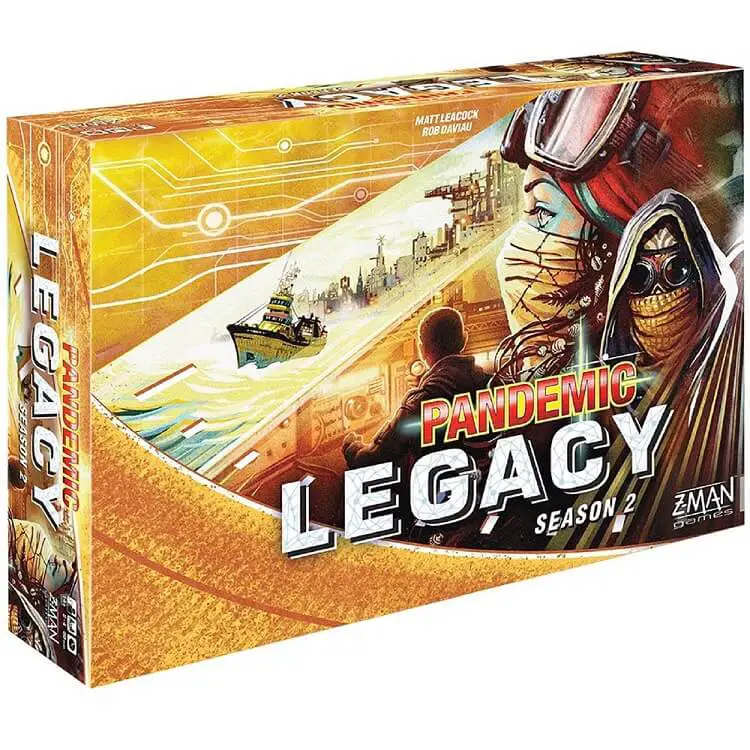
Players: 2 – 4
Duration: 60mins
If you love Pandemic Legacy Season 1… then season 2 is an absolute necessity. The game picks up right where you left off in season 1 depending on the ‘finale’ you encountered.
Again, the game focuses on 12 months (play throughs) that means anywhere from 12 – 24 hours of gameplay BUT the game does differ from Vanilla Pandemic and season 1.
In season 2, instead of trying to prevent diseases from spreading, players are forced to try and keep cities on the map fully supplied.
This means a completely different set up and a different feeling game – with the same story.
This is HUGE for board gaming and an awesome change to the norm. 2 Board games that have a continuous story perfectly customized to the players playing it.
Both games use the same characters and story, but are played like different games. This is campaign gaming at its absolute best!
Gameplay
Gameplay in season 2 is the same as season 1 – the only difference being the story. Which I will not ruin for you in this article!
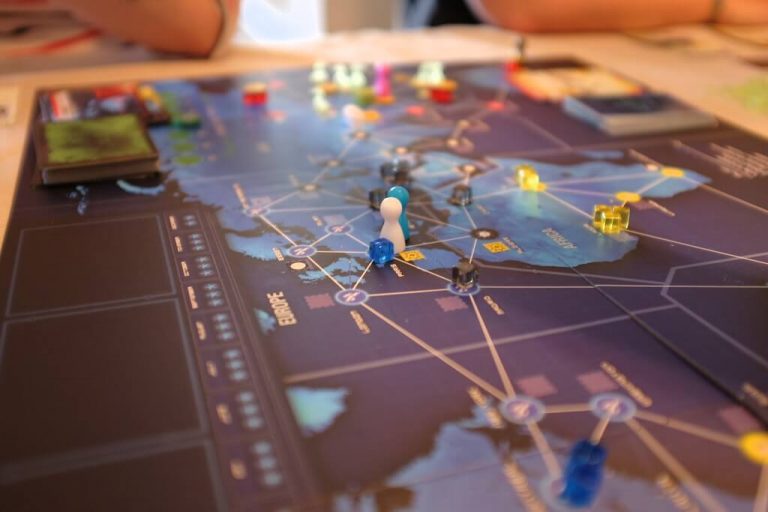
Bottom Line
If you loved Season 1 of Pandemic Legacy then you HAVE to continue the story with season 2. It is just as good as the first and continues the story right where you left off.
I am so excited for the release of season 3 to finish off the trilogy. Bring on the end of the year!
Pros:
- Huge amount of personalization
- Absolutely perfect mechanics
- Hugely addictive gameplay
- Game scales based on player successes and failures
Cons:
- Hard to resist playing… seriously
5. Ultimate Werewolf Legacy
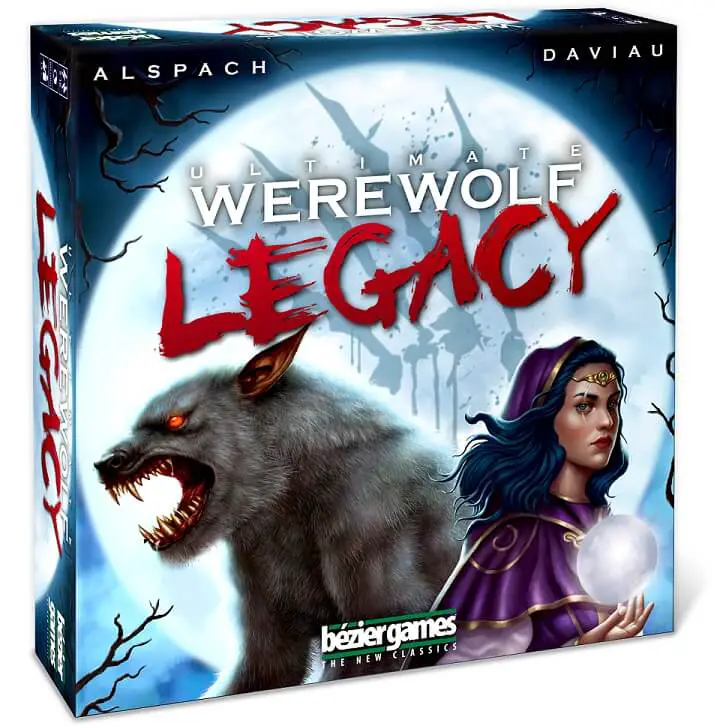
Players: 8 – 16
Duration: 60mins
Ultimate Werewolf Legacy is the best legacy game for parties. Period.
The game is played between 8 – 16 players and is a hidden identity game where some players are innocent villagers while the other players are werewolves.
The villagers have no idea which players are werewolves and the werewolves need to remain hidden and undiscovered while slowly eliminating the villagers one by one.
The game is a ton of fun to play with a large group of people. It builds on the Ultimate Werewolf game and is meant for multiple play throughs of the game whereby events and decisions that take place in prior games have effects which are retained and ripple through remaining games.
One simple bad decision can haunt the village for years to come!
The game is a LOT of fun, and if you have the right mix of people can mean hours of socializing and entertainment.
Gameplay
The legacy version of Ultimate Werewolf builds on the mechanics of the original game. Basically, at the start of the game players are handed a card that tells them whether they are either a villager or a werewolf.
The number of werewolves depends on the player count, and they win the game if they are able to kill all villagers while remaining undetected.
Each game has one player who sits out of each round called the moderator who essentially runs the game and makes sure each phase is played smoothly and that no one cheats!
If you would like to read more detail about the original game mechanics and how the game is played then click here to read my article about the best hidden identity board games where I go into this in more depth.
For this article I will focus on the legacy aspects of the game.
The first difference you will note to the base game is that the game comes in a huge and heavy box. This is very different to the base game which comes as a pack containing only two decks of cards.
The main component that makes up this box is the leather-bound diary which has everything required for the moderator to host 15 rounds (that’s right… 15) of the game broken into 3 chapters with 5 rounds each.
NOTE: The moderator does not have to be the same person through each game and you can switch it up if you prefer.
Now I don’t want to reveal too much. But the game is BRILLIANT. Every decision made by players in each game has an effect on later rounds of the game.
These benefit individual players and can be used whether they are werewolves OR villagers in future rounds.
Bottom Line
Ultimate Werewolf Legacy, takes the simple and immensely fun party game and adds enough bells and whistles with its legacy aspect to absolutely knock the original out of the park.
The diary explains each round in perfect and easy to understand detail, and in true legacy form, leaves players with a climax that leaves you unable to start again.
Pros:
- Great legacy party game
- Amazing interaction
- Perfect hidden identity game that gets everyone involved
Cons:
- Players eliminated early need to wait for the round to end
- Need to buy a replay pack to play again
6. Betrayal Legacy
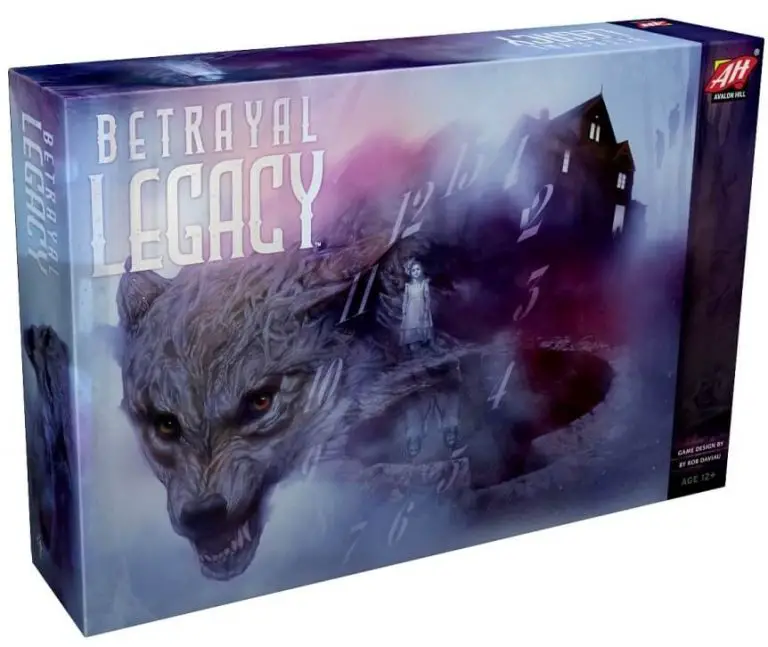
Players: 3 – 5
Duration: 40mins – 90mins
Betrayal Legacy is a brilliant Legacy adaption of the popular horror board game Betrayal at House on the Hill – which is an absolute favorite of mine.
In the game, players enter and explore a haunted house. It is semi-cooperative in the fact that all players work together to explore the mansion until there is a ‘haunt’… whereby suddenly one of your friends turns rogue and starts killing everyone off one by one. The idea is for the non-traitors to make it out of the house alive.
The legacy version of the game has players take on the role of families that are drawn to the house over 14 generations (1666 – 2004). Each generation continues from where the previous generation left off and uncovers more terrible truths of the house.
Gameplay
If you are familiar with the gameplay of Betrayal at House on the Hill then you will have an excellent understanding of how the legacy version of the game works. In this article I will focus on the differences between the original game and the legacy version.
The first big change in the legacy version is that instead of choosing individual characters, each player will choose a different family.
Each family has a unique seal and different traits. During the 14 playthroughs of the game – depending on the outcome of the previous round, players have the option of either aging their current character or introducing a new decedent of the family.
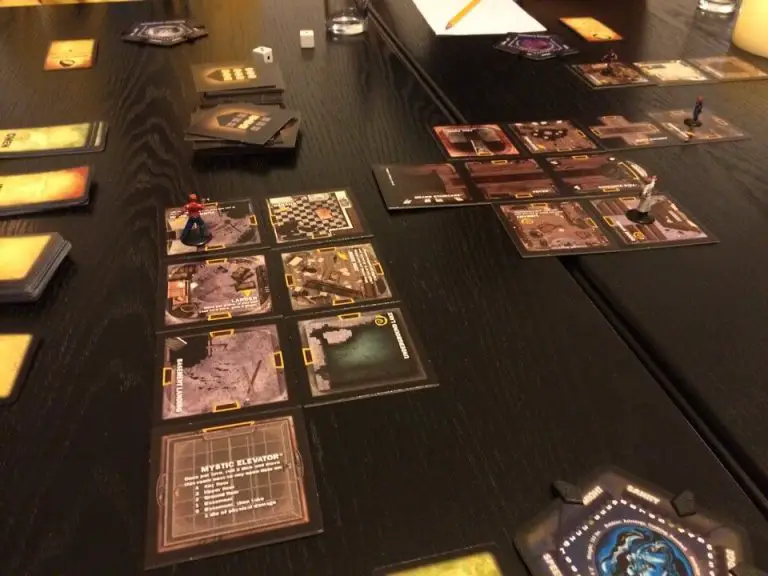
Other changes from the original game are:
- There is the introduction of a ‘Legacy Deck’. Each chapter of the game will have cards drawn from the legacy deck which will change the game and set conditions required to trigger the ‘haunt’ each game. The legacy deck is pre-arranged and is not shuffled.
- There is now an outside of the house with tiles for the front steps. These are the beginning tiles.
- Event and item cards are drawn for the region of the house you are exploring.
- Introduction of heirloom items – these are items that relate to specific families and are passed from generation to generation in the game.
- The bleak journal is a book that legacy cards instruct players to read from. It contains lore and instructions for players to add or remove content from the game.
- Introduction of the ‘Purgatory Deck’ – this deck will add content to the game when the Legacy deck or bleak journal instructs players to do so.
- Once all chapters are completed – there is a huge finale, after which players are able to ‘freeplay’ the game with all revealed content (like the original version of the game).
Bottom Line
Avalon Hill have managed to take an excellent horror co-op game and adapt it perfectly for a legacy game.
It has all aspects of a legacy game, character (family) progression, permanent modifications (stickers) to the game and persistent change throughout a captivating story campaign.
It also has the added benefit of being able to be played as a standalone game once the legacy campaign has been played through!
Pros:
- Brilliant horror theme
- Semi-cooperative game. Hidden identity aspects
- Perfect introduction of legacy aspect and great story
Cons:
- Some haunts are ‘meh’
- Luck factor
7. Charterstone

Players: 1 – 5
Duration: 45mins – 75mins
Charterstone is a legacy board game that is unique as it is a city building / worker placement style game. It’s a completely different genre of game to incorporate a legacy aspect… and surprisingly it works really well.
In the game, players travel to different action spaces to gather and spend resources, collecting victory points along the way. Instead of having individual cities, players work to build and develop a shared village.
The campaign has 12 games where the goal is to earn the most victory points to win the game.
Gameplay
So as not to spoil anything, like all the games in this list. I will only briefly go over the gameplay in this section. A full PDF of the rules can be found here for anyone that is overly curious.
At its core, Charterstone is a worker placement game with the overarching goal being to manage resources and earn the most victory points.
Players play the game on an alternating turn basis and they have the option of placing one of their workers or retrieving all their workers.
In the middle of the board is the ‘commons’ area. This area is a shared area made up of five permanent spots:
- Zeppelin: Allows new spaces to be uncovered on the map so players can build on them;
- Charterstone: Introduces new buildings, crates, players and rules;
- Grandstand: Allows completion of game objectives when visited;
- Treasury:Allows the exchange of resources for currency; and
- Market: Allows purchase of crates, buildings or victory points.
At the start of the game, each player takes control over one 6-plot charter in the shared village.
The charters all start with a basic resource building. Any player is able to visit any charter to use a building.
New buildings are only constructed in a players own charter and, after building it, the empty card is kept by the player and used as a crate.
Crates are able to be opened using the Charterstone building, and will allow players to draw from the ‘Index’ deck which can have permanent changes to how the game is played (i.e. additional rules).
Players continue playing each game in a turn by turn basis until the progress track for each game reaches its end.
The progress market is moved when players carry out actions such as opening crates, construct buildings or gains an advancement.
Players with the most victory points at the end of the game wins.
Bottom Line
At the start of the game Charterstone felt a bit underwhelming. It was just a typical worker placement game – go to building A, pay B and collect C.
But as the game progresses and crates are opened – it adds a whole lot of excitement and complexity to the game.
I love the charter in the game. My main source of enjoyment was trying to make my charter as efficient as possible. Finding the perfect building that synergizes with your other buildings to create an awesome combo is great feeling!
Pros:
- Unique idea turning a worker placement game into a legacy game
- Great quality art and components
- Opening crates and addition of rules keeps the game super interesting
Cons:
- Best played with higher player counts
- Early game is a bit boring
- Opening a lot of crates early on can mean a barrage of new rules to deal with
8. First Martians: Adventures on the Red Planet
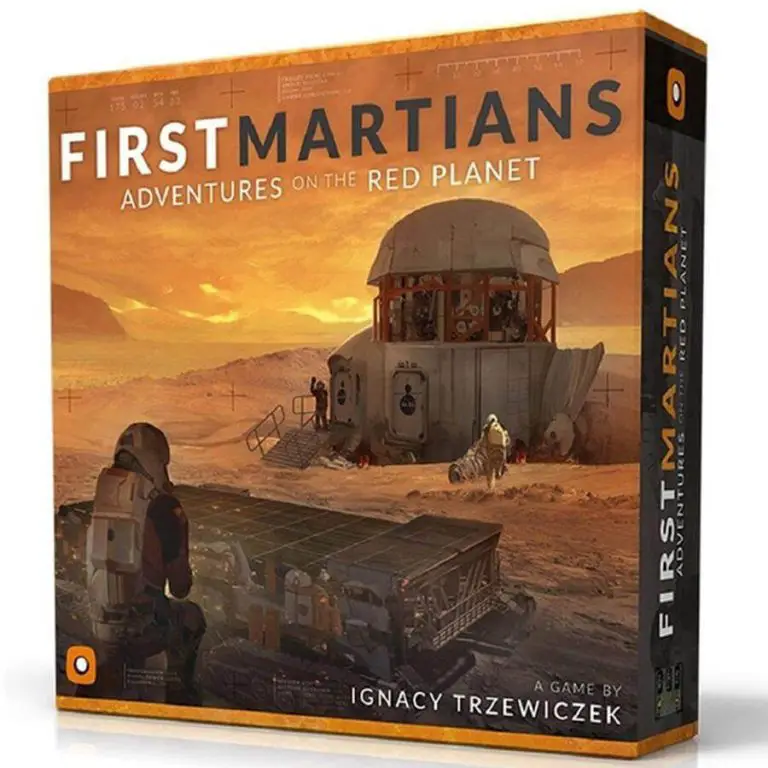
Players: 1 – 4
Duration: 60mins – 90mins
I absolutely LOVE the theme of this game. I am a huge fan of sci-fi and survival board games, so when you combine the two of these AND add a legacy concept you can be sure I will be playing it.
First Martians is a board game that pits the players against the hostile, alien environment of Mars. The game was designed using the core mechanics of the award-winning Robinson Crusoe: Adventures of the Cursed Island, which is my favorite survival board game.
The game also takes advantage of a smartphone app which can be downloaded for iOS or Android, which further adds to the fun and atmosphere of the game.
Gameplay
The theme of the game that you and a few other astronauts (other players) are left stranded on Mars. You need to overcome obstacles and survive the harsh environment on the planet in order to escape with your lives!
In the box, players have access to standalone missions and two different campaigns to play through.
The campaigns are where the legacy aspect of the game comes in, as the second campaign picks off where the first finished to make them feel connected.
The companion app I linked to earlier helps to immerse players in the game and has helpful reminders about board set up and turn order. It also walks players through the various stages of the game. Overall, it’s a great asset!
Another cool aspect of the game is the ‘character generator’. This allows you to put a picture of yourself, your name and title onto a player card to be printed and used in game. So cool!
The two campaigns of the game are made up of 5 missions each. Without spoiling them… let me be frank – these missions are completely unique and utterly brilliant!
Those familiar with Robinson Crusoe will be familiar with how this game plays. The game has a very ‘choose your own destiny’ feel – you can spend the day doing ‘science’ stuff but it all takes time and energy. These are of limited supply.
You could decide to shortcut the science experiments and rush… but that would mean having to roll the dice to see if you are successful or somehow injure yourself or… have to go on an adventure!
An adventure is a random event that occurs – this can be breaking a piece of equipment or a malfunction. These are always bad…
Decisions have to be made about the allocation of resources and time to deal with these ‘mishaps’ – either you spend the whole day fixing what broke or someone comes and helps you.
The whole game is about managing risk / reward. I love this. Every task or objective given to players has a multitude of ways to be dealt with – some super risky, but saves lots of times. Others, slow and steady.
At the start of each game, players are supplied with a mission sheet. These sheets detail what goals need to be achieved to win the game.
Goals can be either mandatory or optional and are tracked in a mission log (and by the app). All mandatory goals must be completed in time to win the game, while voluntary goals will help you to improve the situation you are in, by supplying bonuses such as food or extra parts.
Bottom Line
First Martians is a game that is ideal if you love cooperative survival games. The game uses proven core gameplay mechanics and utilizes a great companion app and theme.
The game is very challenging and gives you a very real sense of urgency and requires you to work together as a team to keep everyone alive.
Pros:
- Very cooperative game – requires all players to work together to win
- Immersive gameplay with app
- Based on proven survival mechanics – adapted for legacy aspects
Cons:
- Not newbie friendly – rules can be complex
9. Aeons End: Legacy
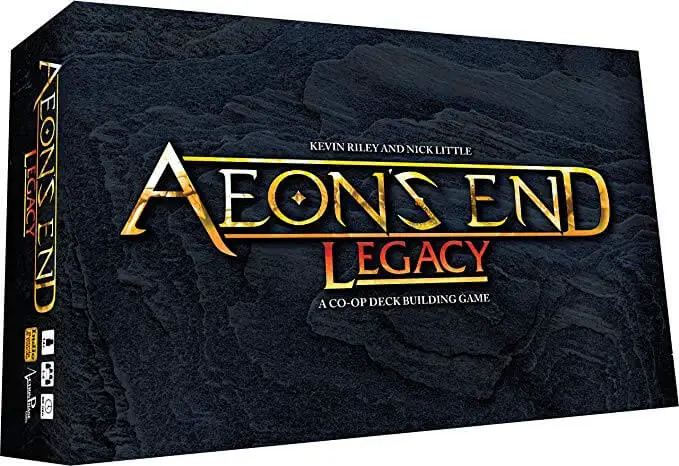
Players: 1 – 4
Duration: 45mins – 90mins
Aeon’s End Legacy is a super fun cooperative deck building legacy game where players take on the roles of Breach Mages who are tasked to protect the city of Gravehold from a being who’s only goal is to destroy humanity.
I have never played any games in the Aeon’s End universe so this was my first introduction and I was very pleasantly surprised.
The game was a huge success on kickstarter, raising over $600,000. It’s highly polished and is a greatly balanced game.
Gameplay
In Aeon’s End, players play through the campaign over 7 chapters. Each chapter comes in a sealed ‘pack’ which can only be opened after the successful completion of the prior chapter.
The game is a deck building game that is fully cooperative. Players need to work together and strategize to ultimately beat each chapter and the game.
At the start of the game players choose and customize their character. They are provided with a starting deck of 10 cards depending on their character choice – and they must use this deck to purchase stronger cards and attack the ‘Nemesis and his minions’.
The legacy aspects of the game come into play right from the character selection phase. Players need to choose which side of the board they will start – Male/Female and must write the name of their characters on the board.
The game incorporates a legacy deck which unlocks permanent changes during the game. These are generally provided in the way of a choice the players get to make. Once the choice is made – the remaining choices are discarded.
The game also incorporates a whole lot of surprises (decks / boxes / inserts). These are spoilers though so I will leave them for you to discover!
The basic flow of the game is that on a player’s turn, they’ll play cards from their hand to either cast spells and attack the monsters or spend money to buy additional cards.
In order to attack, each spell must first be prepared in a ‘Breach’.
A breach is essentially a cooldown. Players need to think ahead as to what spells they will need to use and place them in one of their breaches in order to prep them for their next turn.
At the end of a players turn they will place the cards they used back into the discard pile in an order of their choice – this is important as it will affect how cards are drawn back into their hand in the future!
Another unique aspect is that players turns are not guaranteed to be in the same order each turn. There is a deck called the ‘Turn order deck’ which is shuffled at the end of each round and determines the play order… the catch? – there are two nemesis cards in this deck.
Each time a nemesis card is played. Something bad happens!
Bottom Line
I really loved Aeon’s End: Legacy. The game is super balanced and the story is incredibly immersive.
We played through the game as a group of four and it was incredibly interactive. In order to successfully beat the game – there needs to be a lot of planning and strategizing that needs to happen.
Pros:
- Very tight gameplay – every game feels like it comes down to the wire
- Board game newbie friendly
- Super fun combo moves
- Smooth gameplay
Cons:
- Legacy aspect not as strong as other games on the list
10. Seafall
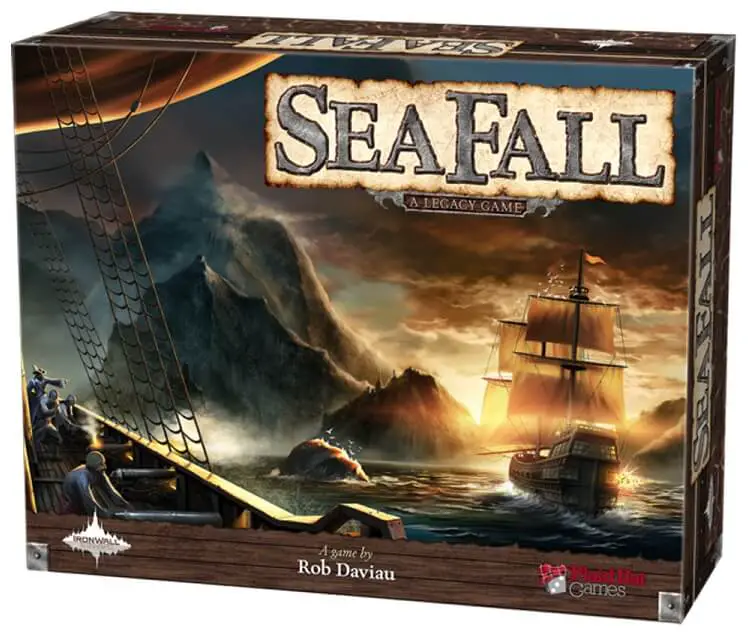
Players: 3 – 5
Duration: 120mins – 180mins
SeaFall was the first legacy board game build from the ground up and did not build upon or adapt a previous title.
The game is the third legacy title designed by Rob Daviau. While in my opinion the game is not as good as both Risk Legacy or Pandemic, it is still such a great game that it deserves a spot in this list.
The game is a roleplaying legacy board game set in a Renaissance world filled with pirates and gunpowder. Five noble families are fighting for control of the empire. Each player takes control of one of the five families, and over the course of the campaign fights for glory (victory points) to win the game.
SeaFall is a game that players either love or hate. The problem is that because of the success of Risk and Pandemic Legacy games it had A LOT to live up to. It had a tremendous amount of hype and big shoes to fill.
In my opinion, the game is good. You just can’t compare it to Risk or Pandemic. The game itself is without a doubt worth checking out and can stand on its own merits.
Gameplay
At the start of the game players choose one of the five families and that is who they play as for the remainder of the game.
The board starts off with 4 islands. But as players explore and build their exploration capability, the open sea will be uncovered and new islands discovered.
When a site is uncovered you are able to explore them (roll a dice a certain number of times equal to your exploration capability to reach the ‘success’ target). These sites will generally produce goods for the rest of the campaign to the player who uncovers them and is marked by a permanent sticker.
For each game – what you generate on each island is what you are stuck with for the rest of the game. In order to obtain these resources – players have to move between these islands and back to upgrade and build.
The game is played on a turn by turn basis and players have multiple options to choose from (which depend on the guild they choose), each turn players tend to sail and perform one of the following:
- Explore the board, uncover a site and earn victory points;
- Buy goods from an island;
- Buy an upgrade (e.g gunpowder) for your ship and earn victory points;
- Buy a building – this grants a global power and victory points;
- Sell some good for money;
- Get a pittance of money if you are being absolutely dominated in the game;
- Raid a site and earn victory points – if successful you get the sites goods or abilities for free, but at the cost of enmity.

In the beginning there is a huge rush by players to obtain goods. This is because at the beginning of the game all goods are incredibly scarce. As the board grows, goods become abundant and this slows down.
The aim of the game is for players to improve upon and upgrade their powers which increase their chances of rolling successfully during the game.
Unfortunately, (and this is one of SeaFalls main downfalls) is that this introduces a huge and game breaking element of randomness to the game – this has caused a huge uproar amongst hobbyists as there is an unfair risk/reward payoff no matter what strategy you choose.
One of our biggest frustrations was that you can play a low-risk game and accumulate powers to minimise your risk, and still fail, while another player risks it, rolls well and wins.
To win the game – players need to reach the predetermined number of victory points.
Bottom Line
While the game has caused a huge amount of controversy in the board game scene. It is not all bad. Sure, it has its flaws, but the main issue is it is trying to live up to its predecessors like Risk or Pandemic and is not viewed as a standalone game.
We had a lot of fun playing through the game and took it as its own game. It was hard to learn and the rule book could use a lot of work. Does that mean it’s a bad game? No. Are there better legacy games? Yes. But for the price… this is a game that’s hard to beat for value.
Pros:
- Amazing artwork and detail
- Sinking ships are dramatic and awesome
- Board game changes a ton over the campaign
Cons:
- Rules are hard to read and clunky
- Story feels like it is on autopilot
Final Thoughts
While legacy games are a relatively new concept and is highly contested in the board gaming community. One thing is for certain…. They are here to stay!
I personally love Legacy games. Yes, the majority of them have a limited shelf life. But in terms of gameplay and having a super personalized story and campaign… I’m willing to have that trade off.
In this article I have presented what I believe to be the best legacy board games available on the market now. As the genre progresses, I reserve the right to come back an edit this list – I love trying new board games and legacy board games are no different!
I would love to hear about your experiences with legacy games and if you think there are any I should try / should be added to my list.

